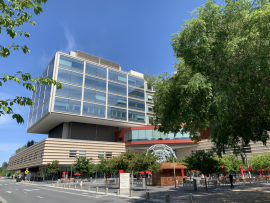Palo Alto, CA — Mahajan’s surgical team was among the first to perform eye surgery in one of the state-of-the-art operating rooms in Stanford’s new hospital. The 824,000-square-foot hospital was designed as a modern center where prevention, treatment, and cutting-edge therapies play equal roles in patient wellness.
Most eye surgeries are performed at the Byers Eye Institute. However, patients with complex medical issues, along with emergency night and weekend surgeries, are taken to the main campus hospital.The operating room must accommodate six surgery team members. These include Mahajan and a surgical assistant, a circulating nurse, a scrub tech, and two anesthesia staff.

Vinit Mahajan M.D., Ph.D., professor and vice chair of ophthalmology research, said, “The new operating rooms are much larger and allow better positioning of the newest surgical equipment. These includes retina surgery devices, lasers, cryotherapy units, intraocular gas, sophisticated retinal microscopes, and the anesthesia equipment. Everything is new.”
“It’s surprising how much space and equipment is needed to effectively perform surgery in the microscopic spaces of the eye," Mahajan added.
The first cases Mahajan performed were emergency repairs of retinal detachments with surgical fellow Natalia Callaway.
“Emergency eye surgery is very stressful for patients and their families, especially when coming to an unfamiliar location. But the new hospital is thoughtfully designed for easy access to the preoperative suites, recovery rooms, and family waiting lounges. Good architectural design can support the healing process, and our environment feels like a luxury hotel, not a hospital,” Mahajan said.
Mahajan sees the new Stanford Hospital, with its investment in biotechnology and support of research, as one of the institutions that will most influence the future of medical practices, patient treatment plans, and prevention. As director of Stanford’s Molecular Surgery Program, Mahajan is at the forefront of Stanford’s effort to predict disease at its earliest stage using proteomics, the large-scale study of proteins.
Mahajan said, “One great example is our recent work on eye cancer with Prithvi Mruthyunjaya, M.D., M.HS., where our surgical biopsies can undergo special handling and protein biomarker analysis. Because we are a research and teaching center, our clinical residents and fellows have the opportunity to directly interact with scientists on the college campus. This creates unique multidisciplinary teams, and we have made significant discoveries on new ways to diagnose eye cancer.”
Over the last decade, the “predict, prevent, and cure” vision of Stanford leaders shaped the design and function of the new Stanford Hospital. As the only Level 1 trauma center between San Jose and San Francisco, the new hospital doubles patient capacity with its 368 single-patient rooms, a 76-bay trauma center, 28 state-of-the-art operating rooms, five gardens, and a meditation room.

